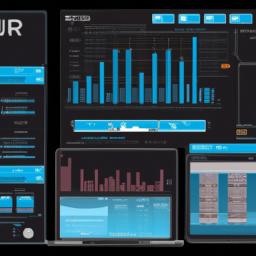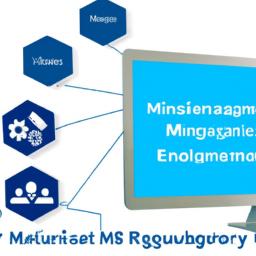SMB ERP Software: Empowering Small and Medium-Sized Businesses
In today’s fast-paced business world, small and medium-sized businesses (SMBs) are constantly seeking ways to stay ahead of the competition. This is where smb erp software comes into play, providing a comprehensive solution to manage and streamline critical business processes. But what exactly is SMB ERP software, and why is it crucial for the growth and success of SMBs?
Defining SMB ERP Software
SMB ERP software, also known as Small and Medium Business Enterprise Resource Planning software, is a powerful tool that integrates various business functions into one centralized system. It allows businesses to efficiently manage their operations, including finance, human resources, inventory management, project management, and customer relationship management. By consolidating these functions, SMB ERP software provides a holistic view of the business, enabling informed decision-making and improved operational efficiency.
Unlocking Benefits for SMBs
Implementing SMB ERP software brings forth a multitude of benefits for small and medium-sized businesses. Firstly, it enhances productivity by automating routine tasks, reducing manual errors, and optimizing workflows. With streamlined processes, employees can focus on value-added activities, boosting overall efficiency and output.
Moreover, SMB ERP software provides real-time insights through robust reporting and analytics capabilities. Business owners and managers gain access to accurate data, enabling them to make data-driven decisions promptly. This increased visibility into key metrics empowers SMBs to identify areas for improvement, capitalize on opportunities, and mitigate risks.
The Expanding Market for SMB ERP Software
The market for SMB ERP software has witnessed significant growth in recent years. As more SMBs recognize the potential of ERP solutions, the demand for tailored software has surged. In response, software providers have developed specialized solutions designed specifically for small and medium-sized businesses.
This growing market offers SMBs a wide range of options to choose from, ensuring that they can find an ERP software solution that aligns with their unique business needs and budgetary constraints.
In the next section, we will delve deeper into the key features and functionalities offered by SMB ERP software, shedding light on how it can revolutionize the way SMBs operate. Join me as we explore the transformational capabilities of this game-changing software!
**
Factors to Consider When Choosing SMB ERP Software
In the vast landscape of SMB ERP software options, choosing the right solution for your business can be a daunting task. With numerous factors to consider, it’s essential to evaluate various aspects before making a decision. Let’s explore the key factors that should guide your selection process:
Understanding Your Unique Business Needs
Every business has its own set of requirements and processes. Before diving into the ERP software market, take the time to thoroughly understand the specific needs of your business. Identify the pain points, bottlenecks, and areas that require improvement. This will help you narrow down the list of software solutions that align with your specific goals and objectives.
Scalability and Flexibility
As your business grows, so will your need for an ERP software solution that can keep up with the increasing demands. Ensure that the software you choose is scalable and flexible enough to accommodate future growth. It should have the capability to handle expanding data volumes, additional users, and changing business requirements without compromising performance.
Integration Capabilities
A seamless integration between your existing systems and the ERP software is crucial for smooth operations. Consider how well the software can integrate with your current applications, databases, and other essential tools. This will prevent any disruptions and minimize the need for manual data entry or duplicate workflows.
User-Friendly Interface and Ease of Implementation
A user-friendly interface is vital to encourage widespread adoption of the ERP software within your organization. Look for software that offers an intuitive and easy-to-navigate interface, reducing the learning curve for employees. Additionally, consider the implementation process. Choose a solution that can be efficiently implemented without causing significant disruption to your daily operations.
Cost Considerations and Return on Investment
Budgetary constraints are a reality for SMBs, making cost considerations a critical factor in the decision-making process. Evaluate the pricing structure of the ERP software, including upfront costs, licensing fees, and ongoing maintenance expenses. However, it’s equally important to consider the potential return on investment (ROI) that the software can bring. Analyze the long-term benefits and efficiencies that the software can provide to justify the initial investment.
By carefully evaluating these factors, you can make an informed decision when selecting the right SMB ERP software solution for your business. In the next section, we will delve into the top SMB ERP software providers in the market, providing you with valuable insights to aid your decision-making process.
**
Top SMB ERP Software Providers
When it comes to selecting the right SMB ERP software for your business, it’s crucial to consider the leading providers in the market. To help you make an informed decision, let’s review and compare some of the top SMB ERP software providers available today.
Review and Comparison
-
Provider A: With a robust suite of features, Provider A offers comprehensive solutions tailored to the needs of SMBs. Their software includes modules for finance, inventory management, human resources, and more. The user-friendly interface and seamless integration capabilities make it a popular choice among businesses.
-
Provider B: Known for its scalability and flexibility, Provider B’s ERP software allows SMBs to easily adapt and grow alongside their business. The software offers advanced customization options, allowing businesses to tailor the system to their specific requirements. Additionally, their excellent customer support and training resources ensure a smooth implementation process.
Features, Pricing, and Customer Reviews
Let’s take a closer look at the features, pricing, and customer reviews for these top SMB ERP software providers:
-
Provider A: Their software includes features such as real-time reporting, inventory tracking, and customer relationship management. Pricing is based on the number of users and modules selected. Customers have praised Provider A’s intuitive interface and responsive customer support.
-
Provider B: Key features of Provider B’s ERP software include financial management, project management, and supply chain optimization. Pricing varies based on the size of the business and specific requirements. Customers have reported increased efficiency and improved decision-making after implementing Provider B’s solution.
Case Studies and Success Stories
To gain insights into the effectiveness of these SMB ERP software providers, let’s explore some real-world case studies and success stories:
-
Company X: Company X, an e-commerce retailer, implemented Provider A’s ERP software to streamline their operations. With integrated modules for inventory management and order processing, they experienced a significant reduction in order fulfillment time and improved customer satisfaction.
-
Company Y: Company Y, a manufacturing firm, opted for Provider B’s ERP software to enhance their production processes. By utilizing the project management and supply chain optimization modules, they achieved better resource allocation, reduced production costs, and increased overall productivity.
By analyzing the features, pricing, and customer reviews, as well as considering real-world success stories, you can make an informed decision when choosing the right SMB ERP software provider for your business needs. In the next section, we will explore the implementation and best practices for SMB ERP software, ensuring a smooth transition and maximum benefits. Let’s continue our journey towards business optimization!
**
Implementation and Best Practices for SMB ERP Software
Implementing SMB ERP software requires careful planning and execution to ensure a smooth transition and maximize its benefits. Here, we will guide you through the step-by-step process of successful implementation, highlight the importance of training and change management, and provide tips for ongoing support and maintenance.
Step-by-Step Implementation Guide
-
Assess Your Business Needs: Before diving into implementation, evaluate your business processes and identify the specific requirements you want your SMB ERP software to fulfill. This analysis will help you choose the right solution and tailor it to your unique needs.
-
Select the Right Software: Research and choose an SMB ERP software solution that aligns with your business requirements, budget, and growth plans. Consider factors such as scalability, integration capabilities, and user-friendliness to ensure a seamless fit.
-
Plan for Data Migration: Develop a comprehensive plan for migrating your existing data to the new ERP system. This includes mapping data fields, cleaning up data inconsistencies, and ensuring data security during the migration process.
-
Customize and Configure: Work closely with your ERP software provider to customize and configure the system according to your business processes. This may involve setting up modules, defining workflows, and creating user roles and permissions.
-
Employee Training and Change Management: Invest in thorough employee training to ensure a smooth transition to the new system. Provide training sessions, workshops, and resources to familiarize employees with the software’s features and functionalities. Additionally, communicate the benefits of the ERP software and address any concerns to facilitate change management.
Ongoing Support and Maintenance
Implementing SMB ERP software is not a one-time event; it requires continuous support and maintenance to ensure optimal performance. Consider the following best practices:
-
Regular Updates and Upgrades: Stay up-to-date with the latest software updates and upgrades provided by your ERP software provider. These updates often include bug fixes, security patches, and new features that enhance the system’s functionality.
-
Data Backup and Security: Implement data backup strategies to prevent data loss and ensure business continuity. Additionally, prioritize data security by implementing robust security measures, such as encryption and access controls, to protect sensitive information.
-
Continuous Training and Support: Provide ongoing training and support to employees to maximize their utilization of the ERP software. This can include refresher courses, knowledge-sharing sessions, and a dedicated support team to address any issues or queries promptly.
Tips for Maximizing Benefits
To extract the maximum value from your SMB ERP software, consider the following tips:
-
Encourage User Adoption: Foster a culture of user adoption by highlighting the benefits of the ERP software and emphasizing its role in improving efficiency and decision-making. Encourage employees to provide feedback and suggestions for continuous improvement.
-
Monitor Key Metrics: Regularly monitor key performance indicators (KPIs) and metrics provided by the ERP software to measure the system’s effectiveness. Use these insights to identify areas for improvement, optimize processes, and drive growth.
-
Collaborate with the ERP Community: Engage with the ERP software community, attend user conferences, and join forums or online communities to exchange ideas and learn from other SMBs’ experiences. This collaboration can provide valuable insights and innovative solutions to enhance your ERP software implementation.
By following these implementation best practices and leveraging ongoing support and maintenance, your SMB can harness the full potential of ERP software. In the next section, we will explore future trends and innovations in the SMB ERP software landscape, giving you a glimpse into the exciting possibilities that lie ahead!
**




